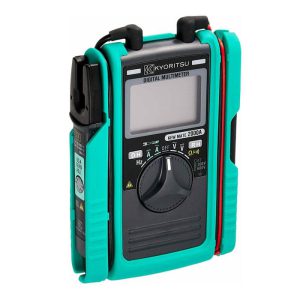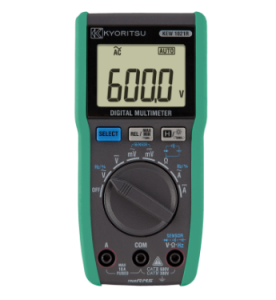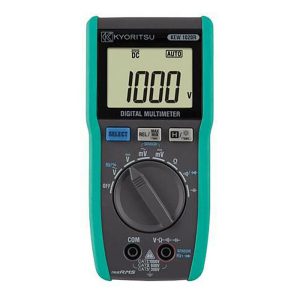There are several options available if you’re seeking for a multimeter to measure various electrical properties like voltage, current, resistance, capacitance, frequency, etc. But not all multimeters are created equal.
You should think about their pricing, accuracy, safety, and many characteristics before purchasing one. I’ll evaluate four Kyoritsu multimeters in this article and help you choose which one best suits your requirements.
Since 1940, the Japanese company Kyoritsu has produced and sold only electrical measuring instruments. They have a standing for excellence and dependability.
They provide a large selection of multimeters for various uses and applications. But not all multimeters are created equal. You should think about their pricing, accuracy, safety, and many characteristics before purchasing one.
Table of Contents
ToggleThe Kyoritsu Analogue Multimeters MODEL 1110
It will be the first multimeter I compare. This simple analogue multimeter can detect resistance up to 20M, DC current up to 250mA, and AC and DC voltage up to 1000V.
It incorporates a zero-center meter for polarity signaling and a mirrored scale to lessen parallax mistake. It works well with low-voltage circuits and straightforward measurements.
The fact that this multimeter is affordable and simple to use is one of its benefits. It can be used without batteries or using any specific settings. Simply choose a range and attach the probes to the circuit. By looking at the direction of the needle, you may also use it to verify the polarity of batteries or diodes.
This multimeter does, however, have several drawbacks. It only has five ranges for each function, has poor precision (0.6% + 4 digits on DCV), and lacks overload safety (fuses or diodes).
This implies that if you apply too much voltage or current to the multimeter, you risk getting erroneous results or damaging it. In comparison to digital multimeters, it is both large and hefty (approximately 500g). It becomes less handy and portable as a result.
Beginners or hobbyists looking for a low-cost, simple-to-use multimeter for fundamental measurements might choose this one. However, you might want to consider other options if you require more precision, features, or safety.
The Kyoritsu KEWMATE 2000A
This multimiter will be the subject of my second multimeter comparison. This digital multimeter can measure AC and DC currents up to 60A without tripping the circuit thanks to its open clamp sensor.
This method of sensing high currents in wires or cables is very practical and secure. Additionally, it has a bargraph display, is pocket-sized (weighs about 150g), and has rubber cable protection.
It can measure resistance up to 34M, continuity, frequency up to 10kHz, and diode testing. It can also measure AC and DC voltage up to 600V. It satisfies the safety requirements of IEC 61010-1 CAT III 300V / CAT II 600V and has a high accuracy (0.8% + 3 digits on DCV) and resolution (0.1mV on DCV).
This multimeter’s ability to measure currents without disrupting the circuit or exposing you to live wires is one of its benefits. To read the display, you just clamp the sensor around the wire or cable.
With the probes, you can also use it to test diodes and measure voltage, resistance, continuity, and other variables. It can detect minute changes in the readings because to its great accuracy and resolution. A bargraph display that can illustrate trends or variations in the measurements is also included.
This multimeter does, however, have several drawbacks. In order to test capacitors or pulse-width modulation signals, it cannot assess capacitance or duty cycle.
Additionally, because of its 6mm maximum conductor size, thicker wires or cables might not be able to be clamped. Additionally, it needs two AAA batteries to operate, which could eventually run out.
Professionals or technicians that require a dependable and adaptable multimeter for measuring currents in various applications may consider this multimeter. However, you might want to consider other options if you need to measure capacitance or duty cycle.
The Kyoritsu Digital Multimeter 1021R
It is the third multimeter I shall evaluate. A genuine RMS digital multimeter, it measures AC and DC voltage up to 1000V, current up to 10A (or up to 200A with an external clamp sensor), capacitance up to 1000F, frequency up to 99.99kHz, duty cycle (10% – 90%), diode test, and continuity.
It contains two detachable holders (flat and wing type), a big display with lighting (6000 counts), and a min/max function.
It satisfies the safety requirements of IEC 61010-1 CAT IV 300V / CAT III 600V / CAT II 1000V and has a high accuracy (0.5% + 3 digits on DCV) and resolution (0.01mV on DCV).
This multimeter’s ability to measure actual RMS AC voltage and current readings, which are more accurate than average values for distorted or non-sinusoidal waveforms, is one of its benefits.
Additionally
It has a broad range of measurements for various electrical quantities, including continuity, frequency, duty cycle, and capacitance.
Additionally, it has a sizable backlit display that can show multiple readings simultaneously. Additionally, it has two removable holders that can be used to hold the multimeter at various angles or positions. Additionally, it has a min/max function that can be used to record the measurements’ minimum and maximum values.
This multimeter does, however, have several drawbacks. It is unable to assess inductance or temperature, two important parameters for evaluating thermocouples or coils.
Additionally, it needs two AA batteries to operate, which could deplete over time. Additionally, because of its 10A maximum current range, an external clamp sensor might be required to measure higher currents.
For experienced users or engineers who require a precise and comprehensive multimeter for measuring various electrical quantities in diverse circumstances, this multimeter is a suitable choice. However, you might want to consider other options if you need to measure inductance or temperature.
The Kyoritsu Digital Multimeters Model kew 1020 R
It is the fourth multimeter I shall evaluate. It measures AC and DC voltage up to 1000V, resistance up to 40M, capacitance up to 1000F, frequency up to 99.99kHz, duty cycle (10% – 90%), diode test, and continuity.
This is a real RMS digital multimeter. A clamp sensor mode, a genuine RMS function, a min/max function, a wide display with backlight (6000 counts), and a tough design are all included.
Alternatively, it can measure current using an external clamp sensor. It satisfies the safety requirements of IEC 61010-1 CAT IV 300V / CAT III 600V / CAT II 1000V and has a high accuracy (0.5% + 3 digits on DCV) and resolution (0.01mV on DCV).
This multimeter’s true RMS capability, which can reliably detect AC voltage and current independent of waveform shape, is one of its benefits. Additionally, it has a broad range of measurements for various electrical quantities, including continuity, frequency, duty cycle, and capacitance.
Additionally, it has a sizable backlit display that can show multiple readings simultaneously. Additionally, it has a min/max function that can be used to record the measurements’ minimum and maximum values.
A tough design that can endure spills and shocks is another feature. Additionally, it has a clamp sensor mode that, when an external clamp sensor is connected, can automatically switch to current measurement.
I’ve compared four multimeters from Kyoritsu in this article to assist you choose which is ideal for your requirements. I have outlined the key characteristics, features, and benefits of each multimeter in addition to their drawbacks.
I’ve also provided you with some advice on how to pick the ideal multimeter for your requirements.
As you can see, every multimeter has advantages and disadvantages of its own. The characteristics that are most important to you should be taken into account, together with the cost and functionality of each multimeter.
For more information and customer comments, you should also read some reviews or watch some videos online.
The benefits and drawbacks of each multimeter are listed below:
Analogue multimeters from Kyoritsu, MODEL 1110: Pros: Economical and user-friendly.
Cons:
Limited ranges, lack of overload protection, bulky and heavy, and poor accuracy.
Pros of the Kyoritsu KEWMATE 2000A include its pocket-sized design, ability to measure currents without interrupting a circuit, and rubber cable protection.
Cons:
Limited to a maximum conductor size of 6mm and inability to detect capacitance or duty cycle.
Pros of the Kyoritsu Digital Multimeter 1021R include its wide measuring range, ability to measure correct RMS values of AC voltage and current, large display with backlight, two detachable holders, and min/max function.
Cons:
Current range is only 10A at most, and neither temperature nor inductance can be measured.
Pros: Has a true RMS function, a broad range of measurements, a large display with backlight, a min/max function, a durable design, and clamp sensor mode. Cons: Has a wide measurement range.
Cons:
Cannot directly detect temperature, inductance, or current (only with an external clamp sensor).
I sincerely hope that this information has aided you in making the greatest multimeter decision possible. Please don’t hesitate to get in touch with me if you have any inquiries or suggestions. I appreciate you reading.





